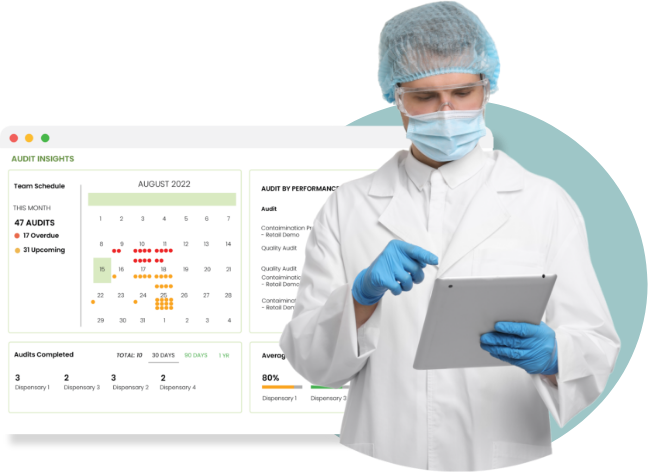Author: Ben Hartman | June 6, 2025 | 5 Min Read
How to Leverage AI for Food Safety - What the Experts Say

Cameras that automatically scan produce for contaminants, sensors that can spot harmful bacteria on the production line, and using data to make quicker, more informed decisions - AI is already changing the face of food safety, and the industry has yet to grasp the full potential of the technology.
At the Food Safety Summit last month, two food industry experts tackled the impact of this emerging technology in the panel “Leveraging AI for a Safer Today and Tomorrow.” Among other topics, the experts offered their advice and predictions on the role of AI in food safety, what it means for food safety employees, and how it will shape risk management and assessment in the years to come.
Here are some of their main takeaways.
It’s about helping people handle complexity
There is a tendency to think of artificial intelligence systems as platforms operating in the absence of people, often after having replaced them. According to panelist Purni Wickramasinghe, Ph.D., these systems are meant to empower employees as they grapple with complex demands.
“Food safety is a very complex system that generates a lot of complex data. How do we ensure that we look at all this data that's interconnected to influence a decision? We need to leverage something more than just you and me. We need to leverage a tool and infrastructure, and that's where AI comes in."
Wickramasinghe, who works in Food Safety & Restaurant Solutions for Chick-fil-A, said that AI helps “empower humans to think through complex data sets so that we can make informed, accurate, and fast decisions to ensure food safety.”
Panelist Drew McDonald, Vice President of Quality and Food Safety for Taylor Farms, gave an example of how AI can expedite and simplify especially complex food safety processes, saving time and money on the production floor through what he referred to as “passive mapping.”
“Imagine standing in a window watching someone doing something and writing down every second or every time they went and bent down and took a swab [of a surface] and then taking a picture of them at the location where they did the swab. That would take a lot of time and effort.”
He added, “now we have an overhead view of the facility and the lines and the layout, and the person goes around and the cameras are tracking when they are taking those swabs.”
He also spoke of how AI-powered systems in agriculture can fight contamination by reducing the number of human hands that are touching crops, while also monitoring factors like soil moisture and weather that contribute to pathogen growth and create a more proactive approach to food safety early in the production process.
Data is worthless if you can’t trust it
Effective AI models rely on massive amounts of data. But the data still must be informed and trustworthy to be impactful.
"If we can’t trust the data, then AI is probably not going to help a whole lot. If it’s data we can trust, it should help. It’s all about trusting the data,” Wickramasinghe said.
She said the various forms of data can’t be siloed into different systems.
“You need data that’s integrated and talks to each other to better understand patterns and bolster decision-making."
She added that a company’s food safety lead should be the one in charge of implementing these AI processes because they better understand what food safety requires.
AI is meant to elevate, not replace human jobs
Wickramasinghe described AI systems and human employees as having a sort of symbiotic relationship in which human intelligence is essential for adding meaning to the data.
“Humans add meaning to AI and data. We can have all the complex models and really good data, and if humans are not there to tune, interpret, and decide what thresholds act on outlets and provide content, it doesn't mean anything. Humans are an integral part of the equation,” Wickramasinghe said.
She also said that many of the jobs in the food industry that require heavy labor are hard to staff, and AI may help the industry create better, more technical jobs. She also highlighted jobs the food industry will need, such as microbiologists who can analyze microbial growth data or data specialists.
“What we don't typically have on a food safety team is a data scientist or a data engineer. These are not skill sets that we've historically had, and we haven't thought of them as an integral part of a food safety system. But if I'm building [AI] models, if I'm deploying models, I need somebody to interpret the models. I need somebody to tune the models. I need a data scientist to understand what kind of model I should use for this specific set of data.”
AI Can Elevate Risk Assessment in Food Safety
In food safety, a proactive approach to risk mitigation is far less costly than having to take corrective measures after a safety incident.
With AI, “you are tracking your environmental conditions continuously. You are understanding the impact on your product or whatever you're transporting…You can be proactive instead of reactive,” Wickramasinghe said.
She described three types of AI-driven analysis that can boost risk assessment. These include descriptive analytics, which collect data on processes and problems, diagnostic analytics, which work to identify what contributes to specific programs, and predictive analysis, which seeks to predict the possible results of different processes taken in production.
Don’t Try to Do Much, Tell a Good Story
During the closing segment, audience members asked questions about AI adoption in food safety.
Drew McDonald said the first major challenge his company faced was “wanting to do too much too soon.”
He described how the company decided to implement a new label reading system that used a laser to scan labels. Then they began using the technology to scan for defects and layering on more and more tasks, “and it just very much drifted from the original charge.”
He added, “I know it’s a cliche, but take baby steps. Start basic and then test it with another challenge.”
Wickramasinghe encouraged attendees to take online classes for using AI and to consider learning how to code as well. She also stressed the importance of telling a good story.
“Learn how to tell an impactful story because AI, technology, big data, all of it can feel very scary and very new. The way you take away that fear factor associated with it or the lack of interest in adopting it is to tell a really good story.”
Food Safety Magazine has made all sessions from the summit available on-demand. To view the session “Leveraging AI for a Safer Today and Tomorrow,” fill out the form here.
Contributors

Ben Hartman
From HACCP certification to the basics of hygiene, our on-demand courseware has you covered.



.jpg?width=120&height=80&name=Baby%20(1).jpg)






